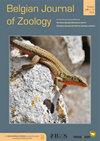比利时巧克力带蜗牛Eobania蛭石的持续种群(腹足目:蜗牛科)
IF 1.3
4区 生物学
Q2 ZOOLOGY
引用次数: 10
摘要
Eobania蛭石(O.F.Müller,1774)是一种大型陆地蜗牛,最大外壳宽度为33毫米。该物种分布在各种栖息地,通常分布在干燥的植被中、灌木篱笆、花园、葡萄园和农田中,通常分布于沿海地区。繁殖发生在秋天。大约有60到80个鸡蛋产在土壤中。蜗牛孵化两年后就成熟了。成年蜗牛在土壤中的一个洞里冬眠,并发育出一个表皮。幼兽通常在石头或树叶下冬眠[1,2]。蛭石Eobania蛭石是一种环地中海物种。它的原生范围从西班牙延伸到欧洲的土耳其,沿着北非海岸至少从摩洛哥延伸到利比亚,尽管它作为地中海地区东南部的原生物种并不存在。该物种已被引入几个欧洲国家,包括德国、匈牙利和荷兰。引入种群也出现在美国、澳大利亚、日本、南非、埃及、以色列、沙特阿拉伯、约旦和伊朗[1-9]。本文章由计算机程序翻译,如有差异,请以英文原文为准。
A persistent population of the chocolate-band snail Eobania vermiculata (Gastropoda: Helicidae) in Belgium
Eobania vermiculata (O.F. Müller, 1774) is a large land snail species, with a maximum shell width of 33 mm. The species occurs in a variety of habitats, usually in dry vegetation, in hedgerows, gardens, vineyards and agricultural fields, often in coastal areas. Reproduction takes place in autumn. About 60 to 80 eggs are laid in the soil. The snails reach maturity two years after hatching. Adult snails hibernate in a hole in the soil and develop an epiphragma. Juveniles usually hibernate under stones or leaves [1,2]. Eobania vermiculata is a circum-Mediterranean species. Its native range extends from Spain to Turkey in Europe and along the North-African coast at least from Morocco to Libya, although it is absent as a native species in the SE of the Mediterranean region. The species has been introduced into several European countries, including Germany, Hungary, and The Netherlands. Introduced populations also occur in the USA, Australia, Japan, South Africa, Egypt, Israel, Saudi Arabia, Jordan, and Iran [1-9].
求助全文
通过发布文献求助,成功后即可免费获取论文全文。
去求助
来源期刊

Belgian Journal of Zoology
生物-动物学
CiteScore
1.90
自引率
0.00%
发文量
10
审稿时长
>12 weeks
期刊介绍:
The Belgian Journal of Zoology is an open access journal publishing high-quality research papers in English that are original, of broad interest and hypothesis-driven. Manuscripts on all aspects of zoology are considered, including anatomy, behaviour, developmental biology, ecology, evolution, genetics, genomics and physiology. Manuscripts on veterinary topics are outside of the journal’s scope. The Belgian Journal of Zoology also welcomes reviews, especially from complex or poorly understood research fields in zoology. The Belgian Journal of Zoology does no longer publish purely taxonomic papers. Surveys and reports on novel or invasive animal species for Belgium are considered only if sufficient new biological or biogeographic information is included.
 求助内容:
求助内容: 应助结果提醒方式:
应助结果提醒方式:


